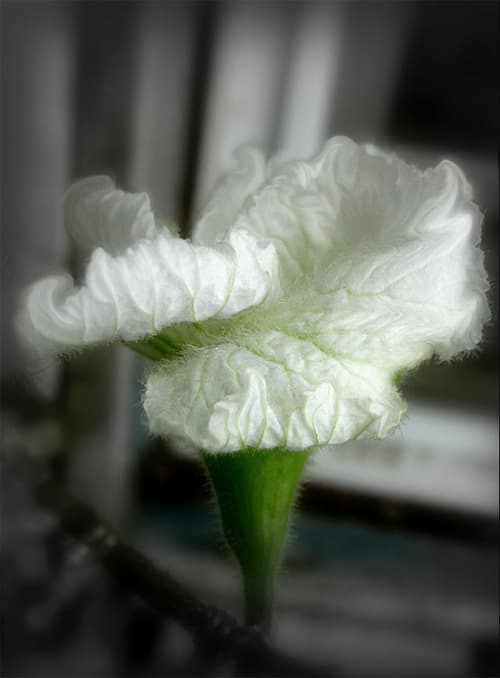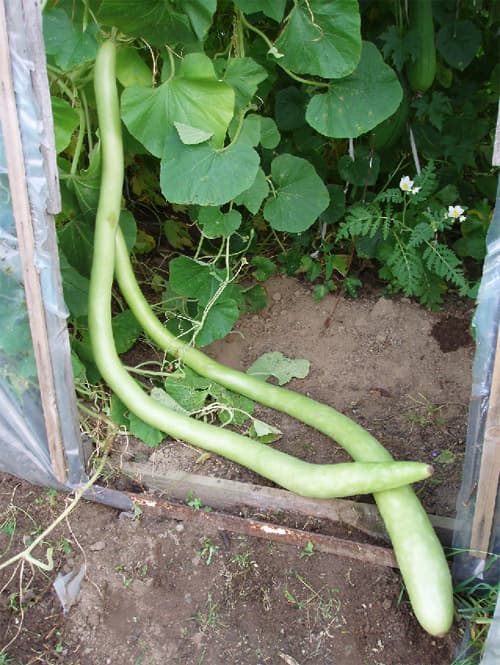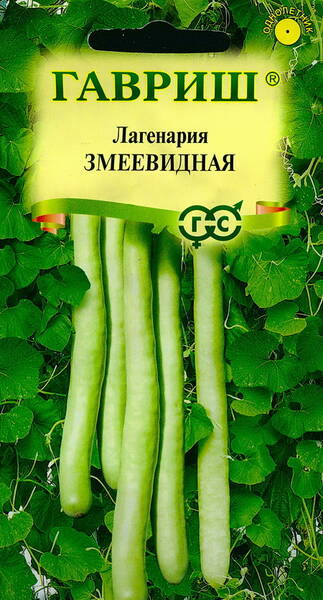Dietary product.
Crop requiring rich and well fertilised soil. Provide support on planting. Young fruits are used like courgettes.
Fruit can be cut continuously, remainder of fruits on the plants do not rot.

What is its attractive feature?
First of all, in its unpretentiousness (it gets along well in a community with other plants and trees): planted under an apple tree, it rises to its very top.
Planted near a fence, it twines it with luxurious greenery and enchants with large, pale cream flowers - beautiful as a smile.
The flowers usually bloom in the evening and droop in the morning. Placed in a room, it quickly rises to the top of the window and covers it with a translucent emerald curtain.
Its main feature is its tireless productivity.
The fruits of the Indian cucumber have an excellent taste and high dietary qualities. When the fruits are still small (25-30 cm long), they are eaten like ordinary cucumbers and are not inferior to them in taste. Various dishes are prepared from the grown fruits, which reach 2 m in length and weigh 7-10 kg. After peeling, you can make a salad with vinegar. This cucumber is fried like zucchini - in oil. Olive oil is better suited for this purpose. Excellent caviar, delicious sauces are prepared from it, even porridge with milk is cooked. The fruit grows incredibly quickly: 8-10 cm per day. The Indian cucumber grows under favorable weather conditions until late autumn, until frost. As a southerner, it loves a lot of sun and warmth, prefers loose and well-fertilized soil. Depending on the place of cultivation, one or another technology for cultivating this miracle cucumber is used.
Indoor cultivation of Indian cucumbers is most often resorted to by city dwellers who do not have either summer cottages or garden beds. It can be grown in spacious corridors of hospitals and schools, in hotel lobbies...
What is required for this?
First of all, you need to stock up on a suitable wooden tub or box with a capacity of 10-15 liters. The bottom must have a hole for draining excess water. The tub (box) is filled with soil prepared from two parts of fertile garden soil and one part of rotted manure (soil from greenhouses and hothouses is well suited). One or two glasses of wood ash or four to five tablespoons of finely ground chalk are added to this mass. All this is thoroughly mixed and the tub is filled with the mixture. If the tub or box has no legs, then they are placed on pieces of brick or wooden blocks. A small flat vessel is placed under the tub (box) to collect seeping water. The plant is placed near the brightest window. Since the Indian cucumber grows strongly in height and width, the growth of its green mass must be regulated: at a certain time, the upper growth point of the central stem and lateral shoots (lashes) are removed. The verticality of the plant is maintained with the help of cords lowered from the window ledge: the plant clings to them with its tendrils.

Bot. syn.: Cucumis bicirrha Forster ex Guillemin, Cucumis lagenarius Dumort., nom. nud., Cucumis mairei H.Lev., Cucurbita lagenaria L., Cucurbita leucantha Duchesne, Cucurbita longa hort., Cucurbita siceraria Molina, Lagenaria lagenaria (L.) Cockerell, nom. inval., Lagenaria leucantha Rusby, Lagenaria vulgaris Ser.
Lagenaria is a little-known plant of the Pumpkin family. The fruits resemble cucumbers in shape and zucchini in color. That is why lagenaria is popularly called Vietnamese or Indian cucumber (Vietnamese or Indian zucchini).
It is recommended to eat young unripe fruits 30-50 cm long. They grow very quickly and reach 2 m in length (their weight can reach 7 kg).
Without cutting off the entire fruit, you can cut off only a small part of it for culinary use: the cut does not rot, and the fruit continues to grow.
Lagenaria fruits are a dietary product. Salads, ketchup, pancakes are made from them, they are stuffed with various fillings, fried. And in the fall, after harvesting, small fruits are pickled like regular zucchini, and large ones are used to make caviar, which is tastier and healthier than zucchini. Unripe fruits have thin skin, so they are removed when pickling.
In our climate, lagenaria is grown using seedlings.












